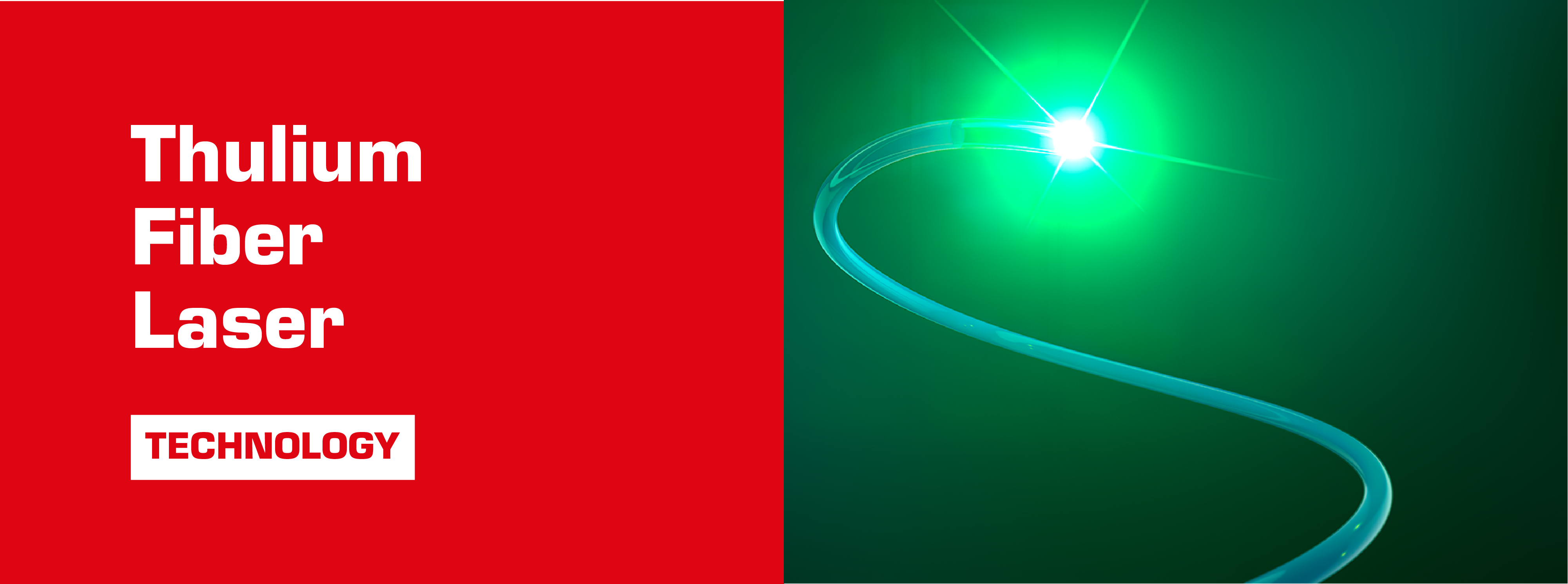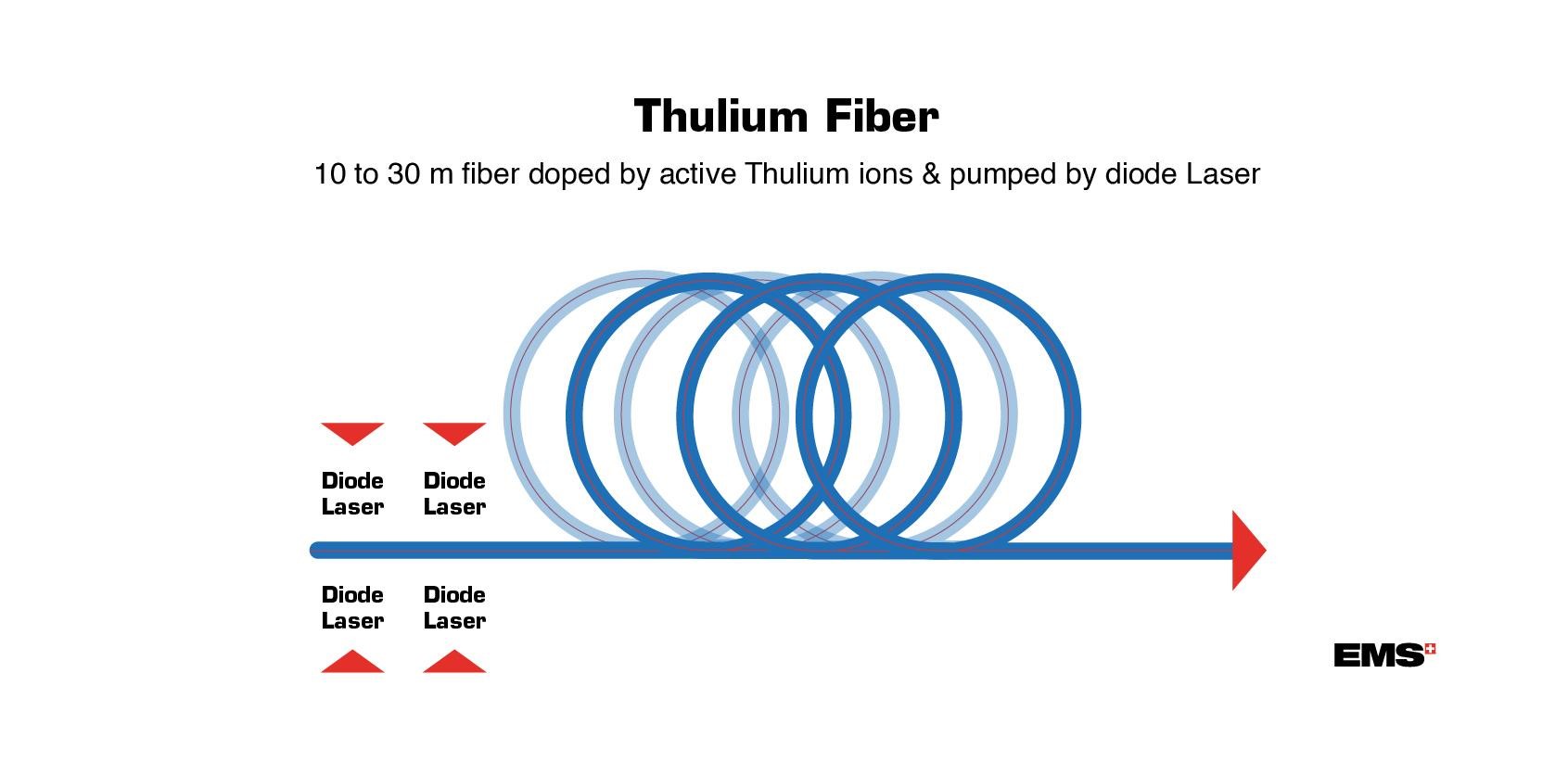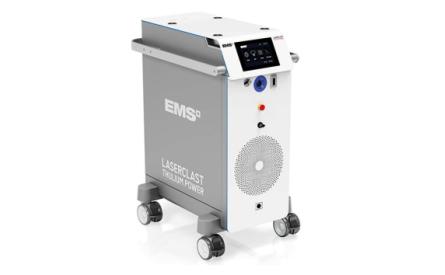
Thulium Fiber Laser - meet the game changer in laser technology.
Thulium fiber laser technology explained
Thulium fiber laser (TFL) uses long, thin and thulium-doped silica fiber as the active laser medium. Multiple diode lasers are pumping energy through the fiber and excite the thulium ions. Photons are emitted at 1940 nm wavelength and directed at the operational field via an outgoing laser fiber.
There are two operating modes to choose from - the continuous and pulsed mode. Furthermore, TFL can operate within different energy, frequency and pulse shape settings. A highly efficient pumping mechanism allows obtaining high powers while generating small amounts of heat. Consequently, there is a significantly smaller cooling apparatus in the machine compared to other laser systems, reducing the overall weight of a TFL system. Thanks to the thin gain medium and more uniform spatial profile, smaller surgical fibers can be employed.

Key clinical applications of TFL technology
Stone management
One of the main applications of laser technology (including Ho:YAG and TFL) is flexible ureteroscopy, used for ureteric and kidney stone management. This both diagnostic and therapeutic procedure allows for minimally invasive stone management without breaking the skin barrier.
Soft Tissue Treatment
The cutting-edge thulium fiber laser technology allows for conducting procedures diagnosing and treating soft tissue conditions, including the management of benign prostate hyperplasia (BPH).

BPH treatment
Laser treatment options for BPH include vaporization, endoscopic enucleation (EEP), resection and ablation. In a majority of cases, EEP is the favoured method. Even though various lasers have been tested for treating EEP, the significant efficacy of the holmium lasers prompted holmium laser enucleation (HoLEP) to be the preferred choice. It allows removing a large amount of tissue in prostates of all sizes.
However, the recent addition of the thulium fiber laser to the urological arsenal might shift the paradigm. Given that TFL has identical average and peak powers of 100W, the laser does not burst tissues, providing clean and precise cutting.
What are the differences between Ho:YAG and Tm-Fiber technologies?
“Finer and faster”
Holmium:YAG laser has been used in urology for more than two decades (learn more about Ho:YAG laser here). Various key advantages over other existing lithotripsy techniques have established this method as a principal laser lithotripter [1, 2]. However, recent technological advances have resulted in the advent of new promising technology - the thulium fiber laser. According to previous studies, thulium fiber laser has the following advantages over Ho:YAG laser regarding laser lithotripsy [1,2]:

Highly effective fragmentation and dusting
Although the holmium:YAG (Ho:YAG) laser lithotripter can operate at high pulse energies, the efficient operation during lithotripsy is limited to low pulse rates (∼10 Hz). Conversely, the thulium fiber laser is limited to low pulse energies but operates efficiently at high pulse rates (up to 1000 Hz). The higher pulse rate significantly improves dusting - a higher quantity of dust and a smaller volume of particles [1,2].

Increased safety profile
The TFL wavelength (λ = 1908 nm) matches a high-temperature water absorption peak in tissue to a greater extent than is the case with the Ho:YAG wavelength (λ = 2120). As a result, the stone ablation may be enhanced.[2]. Moreover, lower tissue and water penetration depth are beneficial for the safety of the TFL [1].

Improved handling due to smaller fibers and better operability
The laser beam exiting the surgical fiber connector is about 16 times smaller, allowing to decrease the diameter of the fiber from 200 µm down to 50 µm. Hence, it is possible to increase the laser energy and provide more focused laser light: 70 µm in TFL vs. 300 µm in Ho:YAG. The flexibility of smaller fibers significantly facilitates the operating of a minuscule ureteroscope in demanding anatomical locations [1,2]. In addition, the TFL laser fibers are more resistant to breakage and demonstrate less laser fiber burn back, improving the lifetime of fiber and lowering operating costs.
A TFL system comes as a smaller, lighter device, is overall quieter and uses a standard power outlet. In addition, there is no need for water cooling, nor for aligning the lamp and laser mirror before a procedure. This convenience in the operating room saves precious OR space and installation costs, and also allows the device to be used spontaneously if the decision to perform laser surgery is made.

Better visibility with less retropulsion
There is a notable reduction in retropulsion when compared with the Ho:YAG laser. In addition, the smaller fiber enables increased irrigation through the minute working channel within the instrument. This leads to improved visibility that can provide greater safety of the procedure.
Last but not least: super pulse creation
The thulium fiber in TFL allows for pulse prolongation up to 12 ms. Pulses are regular. As a consequence, the power produced by the laser has a constant peak, called the super pulse creation. This effect of pulsation is stable over time allowing for confidence in the laser energy output. On the contrary, the pulses produced by Ho:YAG laser are not equal, as they are produced by flashlights. TFL are produced by electronically driven LEDs opening the possibility of pulse modulation, changing the behavior of the effect of the energy.
Reference
- Traxer O, Keller EX. Thulium fiber laser: the new player for kidney stone treatment? A comparison with Holmium:YAG laser. World J Urol. 2020 Aug;38(8):1883-1894. doi: 10.1007/s00345-019-02654-5. Epub 2019 Feb 6. PMID: 30729311; PMCID: PMC7363731
- Blackmon RL, Irby PB, Fried NM. Comparison of holmium:YAG and thulium fiber laser lithotripsy: ablation thresholds, ablation rates, and retropulsion effects. J Biomed Opt. 2011 Jul;16(7):071403. doi: 10.1117/1.3564884. PMID: 21806249
- Kronenberg P, Traxer O. The laser of the future: reality and expectations about the new thulium fiber laser-a systematic review. Transl Androl Urol. 2019 Sep;8(Suppl 4):S398-S417. doi: 10.21037/tau.2019.08.01. PMID: 31656746; PMCID: PMC6790412.
- Panthier, Frédéric et al. “Comparison of the ablation rates, fissures and fragments produced with 150 µm and 272 µm laser fibers with superpulsed thulium fiber laser: an in vitro study.” World journal of urology vol. 39,6 (2021): 1683-1691. doi:10.1007/s00345-020-03186-z
- Keller, Etienne Xavier et al. “Thulium fiber laser: ready to dust all urinary stone composition types?.” World journal of urologyvol. 39,6 (2021): 1693-1698. doi:10.1007/s00345-020-03217-9
- Andreeva, Viktoria et al. “Preclinical comparison of superpulse thulium fiber laser and a holmium:YAG laser for lithotripsy.” World journal of urology vol. 38,2 (2020): 497-503. doi:10.1007/s00345-019-02785-9
- Kronenberg, Peter et al. “Outcomes of thulium fibre laser for treatment of urinary tract stones: results of a systematic review.” Current opinion in urology vol. 31,2 (2021): 80-86. doi:10.1097/MOU.0000000000000853
- Khusid JA, Khargi R, Seiden B, Sadiq AS, Atallah WM, Gupta M. Thulium fiber laser utilization in urological surgery: A narrative review. Investig Clin Urol. 2021;62(2):136-147. doi:10.4111/icu.20200467

